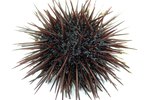
Seahorses are enigmas among ocean life, with their oddly shaped bodies and heads that resemble horses. They aren't very good swimmers, with inefficient, tiny fins on their backs to push them through the water. Because it takes so much energy to swim, they must live in shallow, warm waters that provide plants, rocks and coral to hook their tails to while they rest.
Anchors
Swimming even short distances can wear out a seahorse, so he must find something to wrap his tail around to serve as an anchor while he rests. He often uses plants, grasses, rocks or coral for this purpose. Without the ability to anchor himself, a seahorse would get caught in ocean currents and buffeted out to sea without the ability to swim back home.
Warm Water
Because the best plants and many coral reefs grow closer to shore in tropical or temperate areas, that's where seahorses tend to live. They enjoy the warmer waters in shallow areas, although they sometimes float into slightly deeper waters in the winter when storms are worse. The currents created in shallow waters during strong storms can dislodge seahorses, carrying them out to sea or onto the shore and to their deaths.
Worldwide
Seahorses are found off the coasts of every continent except Antarctica. They tend to stick to areas slightly above and below the equator, not traveling to coastlines where the waters stay overly cold most of the year. They can tolerate wide ranges of salinity, which enables them to live in estuaries and mangrove forests as well as the ocean.
Problems
Because seahorses tend to live close to shore, their habitats are constantly at risk, mostly from human intervention. Boat anchors can pull up grass and plants or damage coral, and fisherman tend to scoop up seahorses as well as other fish in their nets. Some people hunt seahorses to sell as souvenirs or to be dried and used in medicine in some cultures. Pollution along coastlines changes the aquatic environment, killing plants and making the areas uninhabitable by seahorses. According to National Geographic, habitat destruction and harvesting seahorses has left several species in danger of extinction.
References
Photo Credits
-
Comstock Images/Comstock/Getty Images


